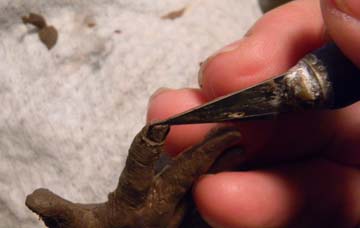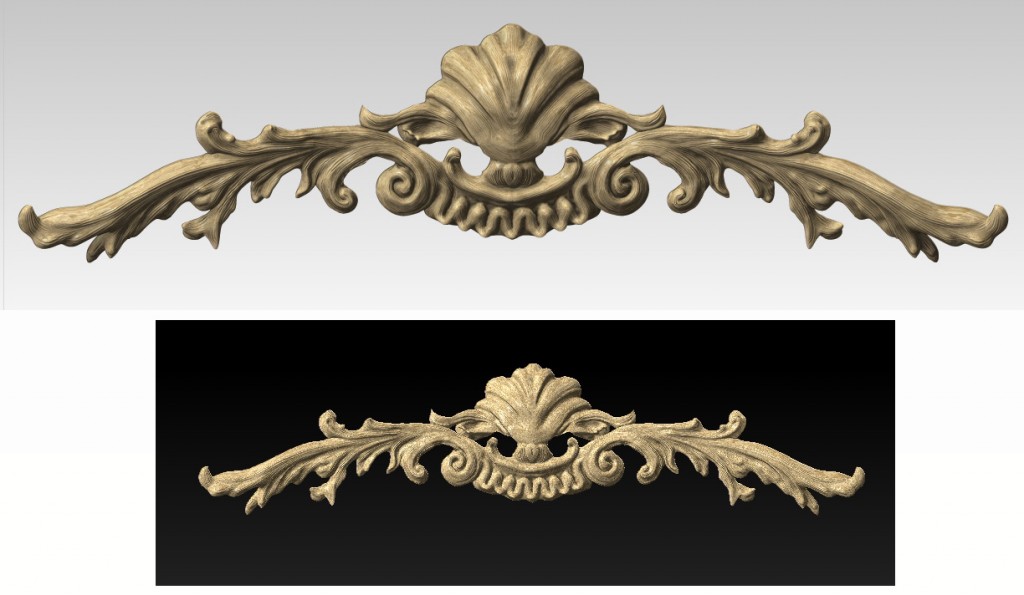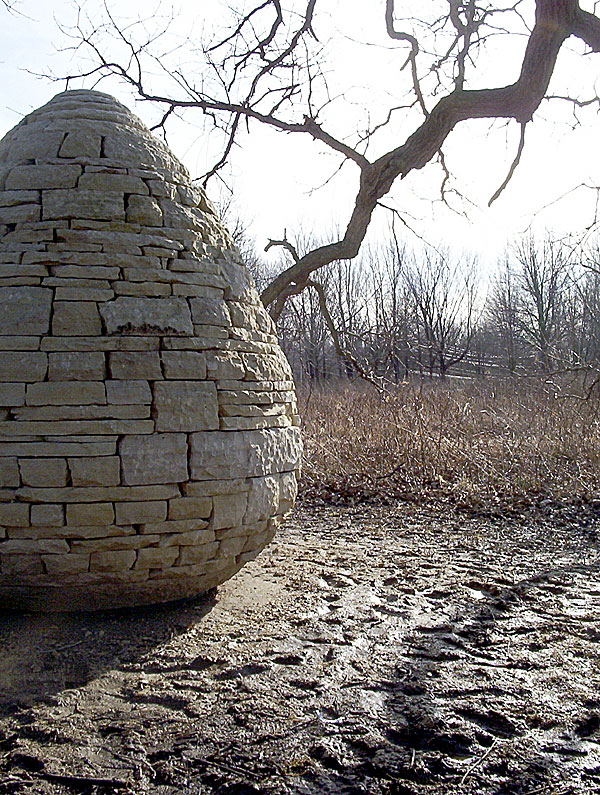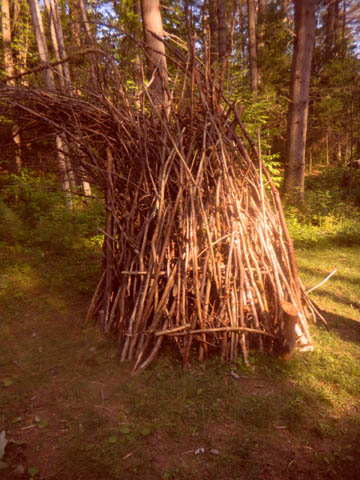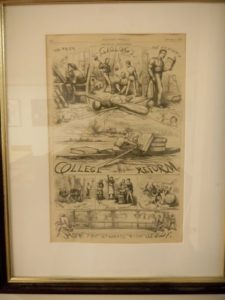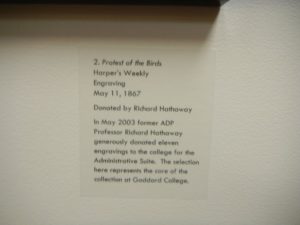Sculpture
Is It Easy For You To Identify And Judge 3-Dimensional Shapes, Distances And Proportions On a Computer Screen? An Interview Cont.
9. Is it easy for you to identify and judge 3-dimensional shapes,
distances and proportions on a computer screen?
1. The hardest part, and we mention this in the book is the size of the sculpture. If I am working on a maquette in the studio, I know if I enlarge that maquette 500% I will not have as much detail as I need. So what is the actual size of a virtual piece of art? What happens with the translation from digital work a the size I have created, to the physical size I need output?
2. I would love to see calipers in the digital programs. Something that resembled more traditional calipers in a digital environment.
3. I also was very confused when I first worked in mudbox with perspective view and orthographic view.
4. There is also a cliche with Macs that if you hit the some keys in a certain order your sculpture flips. This is not just a problem with Mudbox or Zbrush but many graphics programs. This freaked me out, and I wish someone could solve this.
5. It is easier for me to judge 3d space now than in the beginning. Though when symmetry begins to act funky, and I know It is some sort of driver error, I get a bit frustrated. I love being able to spin around a sculpture.
6. I do wish that I had more access to my photographs. The one solution I have found for this is Macs Photstickies.
By the way, question number 8 was
8. Which medium is more comofortable for you to use?
( see other posts)
This is an interview of 10 questions by Mathias Herbster of FH Vorarlberg University in Austria directed to Sculptor Bridgette Mongeon about the comparison of digital and traditional sculpture.
______________________________________________________________

Sculptor, Writer and Speaker
Bridgette Mongeon is a sculptor, writer, illustrator and educator as well as a public speaker.
Her blog can be found at https://creativesculpture.com.
She is also the owner and creator of the God’s Word Collectible Sculpture series
Follow the artists on twitter twitter.com/Sculptorwriter twitter.com/creategodsword
Facebook http://www.facebook.com/bridgette.mongeon
Listen to The Creative Christian Podcast or the Inspiration/Generation Podcast Click on Podcast Host Bios for a list of all podcasts.
Listen to the Art and Technology Podcast
What Makes Sculpting In Clay Appealing To You? An Austrian Student Interview Cont.
1. What makes sculpting in clay appealing to you?
I am a tactile person. I love the feel of clay in my hands, the softness of wet clay out of the bag allowing me to quickly rough in the general shape, the leather hard stage providing the perfect texture for carving in intricate details. The smell of earth, the sound of the water as it is sucked into dry clay in a cup— regenerating it into a malleable medium.
Working in this medium for over 25 years there is more. My brain has developed synapsis that are strictly 3 dimensional. I can quickly rough in a figure and gesture, bringing emotion to an object in clay, much faster than I can in a 2d sketch. In fact, I have noticed that my brain misfires, skips, or bluntly—farts when I am trying to bring thoughts from my brain into two dimensions, though I have continued to sketch my entire life, working in clay or a 3D form helps me to express that creativity quicker. My study of emotion in art, especially facial expression and psychology and science behind that, is exhibited in my sculptural forms and my creations of posthumous sculptures. I have trained myself in the precision of finding the emotion and transferring it to the clay. I’m not sure if this transpires in digital form. It probably does, and I do my best to explain it in my lectures, but it is a very abstruse, imperceptible process.
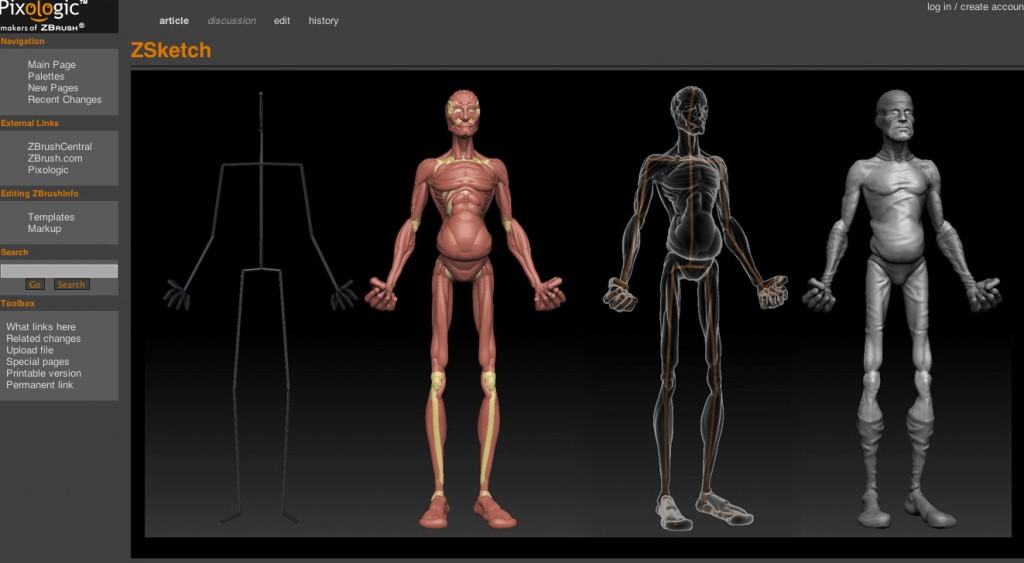
I must say that I do love the immediacy of the medium. I love being able to quickly squeeze and pinch or pull a shape out of a blob. This was probably my most frustrating aspect of digital sculpting, but is quickly changing. I hated having to be bound by the geometry under a piece, it still pisses me off from time to time. Zbrush’s zsketch is more in tuned to my traditional process though I am still butting up against geometry every now and then. I would say the same with being able to pose or move a piece. For me, doing this digitally (Zbrush, Mudbox) is time consuming and leaves me fumbling. I want to play with the form before finalizing it, and I do not feel as comfortable digitally with that as I would like. Some say the geometry is the armature. To me, that is a poor analogy, it is more like grit that is caught in my traditional clay and totally irritating me as I try to dance my hand over it.
This is an interview of 10 questions by Mathias Herbster of FH Vorarlberg University in Austria directed to Sculptor Bridgette Mongeon about the comparison of digital and traditional sculpture.
_____________________________________________________________________________

Sculptor, Writer and Speaker
Bridgette Mongeon is a sculptor, writer, illustrator and educator as well as a public speaker.
Her blog can be found at https://creativesculpture.com.
She is also the owner and creator of the God’s Word Collectible Sculpture series
Follow the artists on twitter twitter.com/Sculptorwriter twitter.com/creategodsword
Facebook http://www.facebook.com/bridgette.mongeon
Listen to The Creative Christian Podcast or the Inspiration/Generation Podcast Click on Podcast Host Bios for a list of all podcasts.
Listen to the Art and Technology Podcast
Sculpting Tiny Hands
When creating a figurine, as I am now, I usually sculpt the head and hands separately. The difficult here is making sure your head, and hands match the size of your sculpted figure.
Because this is a commission piece, I have a full figure photograph of my subject. I can measure how many heads high my subject is and then I can be sure that my head is in correct portion to the body. Believe me there is nothing worse than working on a head for a week and then discovering it does not match the proportion of your sculpture. At this small size a sixteenth of an inch can make a huge difference.
Once I have this done, I can move on to the hands. If you take your hand and put the wrist area at your chin. This is the portion that has the creases in your wrist, and then roll your hand up your face, you will find that your middle finger will come to your hair line. Unless of course you are a middle age man and losing your hair.
To create the hand, I start by making a wire armature. You will see that these fingers in the armature actually have two pieces of wire. I have narrowed the fingers to just one piece of wire later in the process.
Fingers are actually much easier to make when they are not on the hand. Roll small tubes of clay, being sure that you make some smaller or larger (thumb and pinky) than others. Also being sure that right hand and left hand are mirrored and similar in size and shape.
Once I have all of these sausage shapes I’ll roll the side of the sausage in two spots, just above the middle knuckle, and just below. I usually do this on a round tool.
I can then add some more clay for the knuckles and underneath the finger carve out the areas below the knuckle where the finger will bend. A simple angular cut with a knife will do fine. I did that with this tiny finger and then stuck it on the wire. Pushing the tip of the finger up , at the bottom, makes it look much more natural.
FINGERNAILS
Fingernails are really quite easy. With just two strokes of a sharp object I have the basic nail. In this case it is an X-acto knife. Place it on the side, and scrape it over the nail in an arch pattern. Then place it at the other side of the finger nail and bring it to the middle again. A third stroke to separate the nail from the finger at the top is the last portion of sculpting the nail. Push the sharp object in and pull down over the finger tip.
Though I have a good start on this hand, there is one more area that I would like to point out. Note that when your hand is flat the skin flap where your finger meets your knuckle. The pinky and ring finger have a crease that goes to the ouside of the hand and between the middle finger and the index finger the crease is to the thumb.

The two on the right point to the right, the one between the middle finger
and index finger point to the thumb.
MORE SHAPING
The placement of the thumb is also an area that new students will have difficulty with. The thumb is not placed on the same plane as the figners but instead points down to the ground when the fingers are straight up. Also note that the top of the hand is curved and not flat. Because this is a very expressive sculpture, I will be counting on capturing that expression within the hands as well. More on that later. This short little tutorial will get anyone started on a good sculpted hand.
Unfortunately there are two figures in this sculpture and four hands as well as 20 fingers. I can expect to spend a good full day on or a day an a half on hands. I am just thankful thee are no bare feet in the sculpture.
I’ll post some more photographs as I continue.
_____________________________________________________________________________

Bridgette Mongeon is a sculptor, writer, illustrator and educator as well as a public speaker.
Her blog can be found at https://creativesculpture.com.
She is also the owner and creator of the God’s Word Collectible Sculpture series
Follow the artists on twitter twitter.com/Sculptorwriter twitter.com/creategodsword
Facebook http://www.facebook.com/bridgette.mongeon
Listen to The Creative Christian Podcast or the Inspiration/Generation Podcast Click on Podcast Host Bios for a list of all podcasts.
Listen to the Art and Technology Podcast
Visiting Richard Hathaway In Very Deep Snow
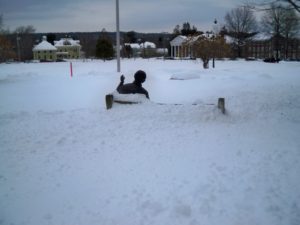
Each time I come up to my graduate residency at Goddard College in Plainfield Vermont I stop by Montpelier to say hello to the Richard Hathaway sculpture. This was the first time there was so much snow. We had to crawl to Richard and when we did Roxi was afraid she would fall in the snow. It was a humorous visit. Each of us took turns taking pictures of the group. I left a snowball, though really wished I could have brought Dick a scarf.

Goddard college each residency to visit.

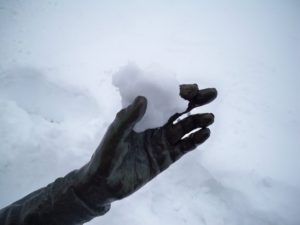
Very Excited About New Marketing Brochure
We have been working diligently on a couple of different marketing plans and target markets. The first is a brochure that is going out to architects, landscape Architects, Interior Designers, and Landscape Designers.
I’m thrilled because it introduced our new digital sculpting services.
This is a tri fold brochure.It has been created by the new intern, Tiffany Post Actually she is not my intern she belongs to my husband’s company, MD Communications next door, but she has been on loan to me for the last couple of weeks. Tiffany is graduating from The Art Institute of Houston. She hopes to get a job in design. I am sure she would be open to freelance work if anyone needs anything, and at a good price. Great way for her to build a portfolio.

It can be a self mailer,
but who could put a label over that lion.
I really like the way the back came out.
Good thing the cards come with envelopes.
The printer we are using on this job was recommended by designer and photographer Christian Sizemore. She also does freelance work. WHCC has reasonable prices and does some nice work.
I would love to hear what others think about the brochure. Will be sent to printer next week.
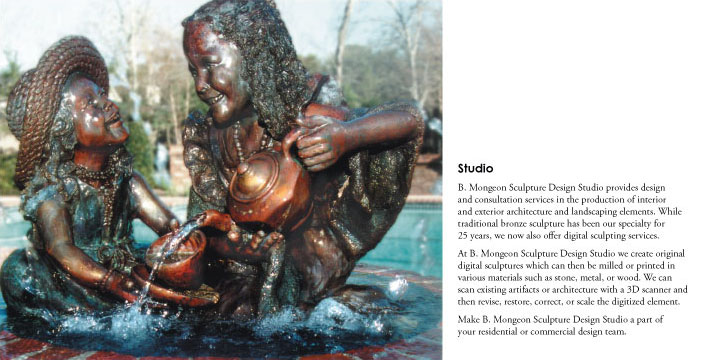

______________________________________________________________________________

Sculptor, Writer and Speaker
Bridgette Mongeon is a sculptor, writer and educator as well as a public speaker.
Her blog can be found at https://creativesculpture.com.
She is also the owner and creator of the God’s Word Collectible Sculpture series
Follow the artists on twitter twitter.com/Sculptorwriter twitter.com/creategodsword
Facebook http://www.facebook.com/bridgette.mongeon
Listen to The Creative Christian Podcast or the Inspiration/Generation Podcast Click on Podcast Host Bios for a list of all podcasts.
Listen to the Art and Technology Podcast
Wow, It Is Like Having An Entirely New Art Tool That Makes My Work Look Spectacular!
I have been learning Zbrush4 for a while now. Though there is so much to learn. I have to admit, I can’t spend nearly as much time with it as I like. Zbrush 4 has something called Best Preview Render. For those of you interested in checking it out there is a link to the pixologic site that shows the details.
I still must study all of the bells and whistles of this feature of Zbrush, however, I must say I am thrilled with just my few tries of this feature. For example, I am including two screen shots in this blog post. One with the render, one without. World of difference. The feature, makes me want to create. It is like pressing a button and someone coming in and making your work look great.
Now back to playing.. uhmm I mean working.
______________________________________________________________________________

-Sculptor, Writer and Speaker
Bridgette Mongeon is a sculptor, writer and educator as well as a public speaker.
Her blog can be found at https://creativesculpture.com.
She is also the owner and creator of the God’s Word Collectible Sculpture series
Follow the artists on twitter twitter.com/Sculptorwriter twitter.com/creategodsword
Facebook http://www.facebook.com/bridgette.mongeon
Listen to The Creative Christian Podcast or the Inspiration/Generation Podcast Click on Podcast Host Bios for a list of all podcasts.
Listen to the Art and Technology Podcast
Trying to Goldsworthy
For many years, I have loved the insightful work of artists and naturalist Andrew Goldsworthy. Goldsworthy creates from nature using branches woven into rock, ice balanced, leaves chained together with thorns that wiggling down a stream, rock changing color and balanced rock. He uses reflection in his creations, natural elements and fights against and works with nature to create. It is the juxtaposition of nature and art or nature in art, or art as nature that calls me to marvel.
I think I have also been influenced by Pamela Callender, a classmate of mine from Goddard. Her work appears rather anonymously on campus. For example The Twig sculpture I found on the trail, I thought of it often when I was working trying to do Goldsworthy. I also loved her braided grass, there was an entire section of a field braided. And these balanced stones pop up everywhere during residency. So, I’m exploring, and attempted some of these adventures on my own. It has been very enlightening.
My first attempt to work with nature was building a nest. I gathered my branches and twigs and sliced up my arms with bamboo shoots hauling them indoors, dumping them on the floor where little bug critters scattered. I liked collecting the items. It made me think of my yard in a different way. Not just as plants, but as material. However, I soon came to realize a very important element of this nature gathering and building, especially as it pertains to nests. Birds gather their materials in the cool of spring. I was building my nest in the middle of a Texas summer with 101 temperatures. Sure I brought all of the materials into a cool, air conditioned room, which the birds don’t have access to, but it was already too late. Heat exhaustion set in, and my nest building was put off a couple of days.

One begins to improvise when trying to create only with nature. Mud is close to clay, and it is not unusual that I, as a sculptor, would turn to it. It was a necessary glue for my nest. My finished nest lacks the luster and intricacy of the blue jay nest I found this spring, when interestingly enough, I was cutting back bamboo. But, I managed to get some a semblance of a large nest.
Prior to building it, I had thought of building several nests of different sizes. Large birdie condo’s that I would hang from… bamboo. After nursing my cut up arms, and heat exhaustion, I smoothed my own ruffled feathers and decided—one was enough.
My next project was also going to entail bamboo. Mostly because it needed thinning again. I had envisioned a large cornucopia slithering tube structure that people would walk up to and peer into and marvel. They would see it from afar, like Goldsworthy art and state, “An artist must live here.” They would be forced to stop and to explore the design. O.K. Maybe I was a little influenced by the “Big Bambu You Can’t, You Won’t, You Don’t Stop” by Mike and Doug Starn and Rock climbers using 5,000 pieces of bamboo. It is a project at the Metropolitan Museum of Art. I had seen the work on Sunday Morning with Charles Osgood.

I had made the decision that using metal to secure the armature was certainly acceptable. (Goldsworthy only uses natural elements.) I appeased myself with the thought that this was bamboo, and I was more of a bonsai artist than a Goldsworthy and twisted the bamboo together.
Once again, the bamboo cut up my arms and ants and pollen fell on my head, causing me to sneeze every few minutes. It was cooler outside, but our Texas October and the pollen that it brings, causes havoc with my allergies. Still, I was committed. I created circles of bamboo of different shapes with longer bits of bamboo and grass at one end. I envisioned this circling around the cornucopia in an intricate manner enticing onlookers and making them marvel at my skills. As hard as I tried, it wasn’t working. I began to think that Goldsworthy must have some type of natural guru thing going to get his material looking so… naturally polished. “More armature.” I exclaimed trucking back to the bamboo for bigger pieces, and more ants and pollen in my hair. After hours of stripping and twinning and weaving bamboo, I had what I thought appeared to be an absolutely glorious, incredible looking —mess. Maybe creating out of nature is just not my thing. Before I could let go of the idea, I had thought about taking my large rings of woven bamboo and chaining them together. Perhaps I would hang them from a tree. But then I thought… I’m pushing here.. I threw the piece aside and went on to another idea.
I had wanted to do something in the pond. I loved how Goldsworthy floated branches on water and then set what looked like red berries in the middle of the branches. This thought intrigued me along with the idea of perhaps gluing my red and orange canna leaves to a rock. I read that Goldsworthy used spit, but I had hoped I could use pond water. I abandoned both ideas as I was not sure what my two turtles would do with these creative pieces of art. Any berries or leaves that I brought to the pond could be poisonous. I might create something nice and at the same time murder my reptile friends in the process. Even if the plants were not poisonous, my 10” turtle is inquisitive and hungry and I doubt I could create anything without her poking her head up in the middle. Ah, maybe I have stumbled upon something cocreating, improvisational art with a turtle. If I create anything for my pond, it will have to be something practical like a floating turtle bathing platform.
Goldsworthy also dug small hole and lined them with things. I entertained this idea for just a short second as I was sure that I or my husband or one of our dogs would fall into the hole twist an ankle and end up in the emergency room. I wondered if anyone ever twisted an ankle in a Goldsworthy hole long after he left and then cussed saying, “Who the heck put that there?”
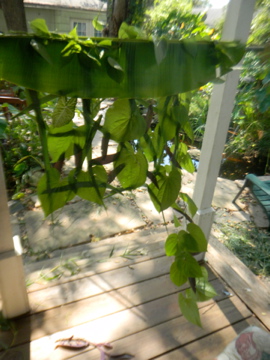
day, Pollen heavy, sneezed often,
poked hands with thorns, decide
Goldsworthy is fun, but not my cup of tea.
Then I thought, “banana leaves.” Not something I thought of on my own,
an idea that stemmed from a Goldsworthy book. I though I’ll hang them and weave things in between them! Oh, certainly this idea would be marvelous and though the artwork that I would labor for hours on would only be temporary, that was the point of this exploration. I was trying to move away from my traditional bronze work for a time to work things that were opposite—not permanent. So, I cut a banana leaves and then another and then another and in hindsight I probably should not have cut them until I absolutely needed them. I thought I heard Goldsworthy fussing at me. The first leave tore terribly, and I adjusted my idea. A banana leaf hanging from something, but what… Oh yes, one of the million of pieces of bamboo that I cut and were now piled knee high in my yard. I felt vindicated. I was on a roll. Later I added donax leaves, potato vines, and other elements to this hanging art. You know, I did enjoy creating this way, even though I was sneezing terribly. I liked looking at the textures and color of my garden and combining them in a way that I had not thought of. I held the banana leaf for a very long time, just feeling its weight, looking at the color, and oh yes, washing off the bird poo. I also thought it was marvelous that the bougainvillea plant on the side of my house that I have been impaled on more than once, now had a purpose. I had plenty of thorns to secure lots of natural pieces.
I have decided to appreciate Goldsworthy from afar. Especially after my experiences with nature. (I feel I have a part of me that is very sad for my inability to coexhist and create with my nature.) I know his descriptions of his artwork usually talk about the weather or the cold or how long it took, or that it fell down and he started over. I give him credit for his tenacity. You know, I do remember reading once that Goldsworthy peed on ice to get it to stick. I think that would be going a little too far, or maybe it would just be harder for a woman than a man, and besides, I would be hard pressed to find ice in Houston at any time of the year. I can only determine that he really enjoys creating in nature to endure and persevere.
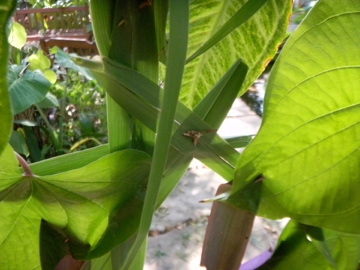
the bougainvillea thorns that I have injured myself on.
One of my biggest distractions of trying to Goldsworthy was my need to do other things in the yard. Clip this plant, move this piece of garden art or fix this part of the pond. I realize that my oasis that I have created out of my yard is my Goldsworthy. The weaving of textures, of height, and color, the exploration of sound by bringing in a waterfall and stream, even the live creatures that now live here. I and my canvas have even endured the natural hardships. I look at the 15 foot tall bird of paradise that hangs over- dead from the very long freeze we had last winter. But I’m delighted with the babies at her dying feet. My canvas will change a bit, but we will also preserver.
I have enjoyed my exploration, and am glad that my turtles are alive. I’m pleased to have washed the pollen out of my hair and the critters off my skin. Not that I mind either, it is just that if I am going to do that I would rather work on my yard and canvas. A lasting Mongeon creation that keeps on giving. I will leave my nature interaction for my garden, the one that I travel through each day and marvel at, as I am on my way to the studio to create!

Bridgette Mongeon is a sculptor, writer and educator as well as a public speaker. Her blog can be found at https://creativesculpture.com.
She is also the owner and creator of the God’s Word Collectible Sculpture series
Follow the artists on twitter twitter.com/Sculptorwriter twitter.com/creategodsword
Facebook http://www.facebook.com/bridgette.mongeon
Listen to The Creative Christian Podcast or the Inspiration/Generation Podcast Click on Podcast Host Bios for a listing of all podcasts
Listen to the Art and Technology Podcast
Memories Of Richard Hathaway.
It Is Becoming A Tradition
Graduate school is at Goddard, just a short drive from Montpelier. Our tradition continues as we stop and see Richard Hathaway each residency- twice a year. I think that Roxy has a thing for the professor. My word it was cold last winter. I was afraid her lips would stick. I so wanted to sneaker skate on the rink made near the sculpture, but it was too cold. None of my classmates would sneaker skate.
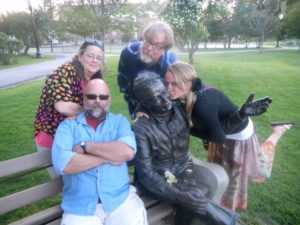
out to dinner and go sick Richard Hathaway






